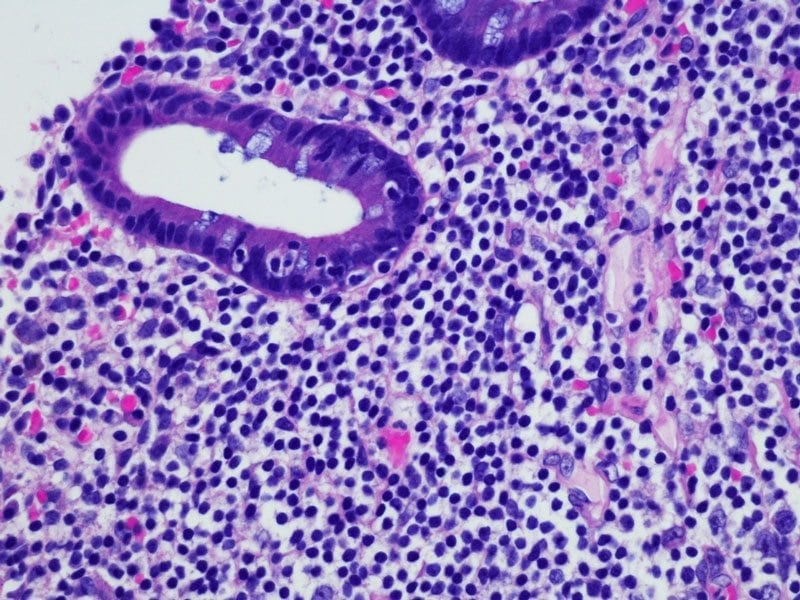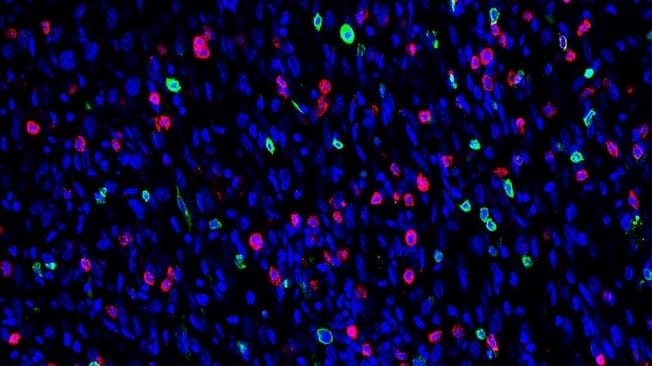
A blood test using infrared spectroscopy can be used to diagnose two types of cancer, lymphoma and melanoma, according to a study led by Georgia State University.
Researchers used mid-infrared spectroscopy to analyze blood serum derived from experimental mice and differentiate mice with non-Hodgkin’s lymphoma and subcutaneous melanoma from healthy mice and also between these two tumorous conditions. The mid-infrared spectral region of the electromagnetic spectrum is frequently used to characterize biological samples at the molecular level.
The findings, published in the journal Scientific Reports, suggest infrared spectroscopy can detect biochemical changes induced by non-Hodgkin’s lymphoma, a solid tumorous condition of the immune system, and subcutaneous melanoma, a deadly form of skin cancer, and has diagnostic potential as a screening technique for these cancers.
Studies have found the incidence rates of cutaneous melanoma have increased in many regions and populations over the last decade, specifically 3 to 7 percent per year among fair-skinned populations. Also, non-Hodgkin’s lymphoma accounts for 4.3 percent of new cancer cases in the United States. The available diagnostic regimen for both cancers, which includes tissue examination and biopsy, is time-consuming, invasive and costly, resulting in small compliance rates of eligible populations for cancer prescreening.
Developing a rapid and reliable prescreening strategy for melanoma and lymphoma is critical because early diagnosis and treatment of these malignancies improve the patients’ chances of survival. Fourier Transform Infrared (FTIR) spectroscopy in Attenuated Total Reflection (ATR) sampling mode provides high-quality results with better reproducibility compared to other vibrational spectroscopy. It has attracted scientists’ attention for its rapid and reliable detection of various health conditions using body fluid samples.
In previous work, Dr. Unil Perera, Regents’ Professor of Physics at Georgia State, and his colleagues discovered that a fast, simple blood test for ulcerative colitis using ATR-FTIR spectroscopy could provide a cheaper, less invasive alternative for screening compared to colonoscopy.
“Our final goal is to say we can use this infrared technique to identify various diseases,” Perera said. “This study shows infrared spectroscopy can identify cancer. Right now, when you go to the doctor, they do blood tests for sugar and several other things, but not for serious diseases like cancer and colitis. If you are a healthy person, there is a range that is normal. One day, we hope that even these serious diseases can be rapidly screened. Your primary doctor could keep a record of your number and check that every time you come back. Then, if there is some indication of cancer or colitis, they can do biopsies, colonoscopies, etc.”
In this recent study, the researchers used mice with lymphoma and melanoma cancers. Blood serum droplets extracted from cancerous mice and control mice were placed on an ATR crystal of the FTIR instrument. Incident infrared beams were absorbed and reflected by the serum, creating a wave that was recorded and used to produce an absorbance curve with peaks that identified the presence of certain biomarkers in the sample.
The researchers compared the absorbance curves from the control and tumorous mice and assessed biochemical changes induced by non-Hodgkin’s lymphoma and subcutaneous melanoma in the serum samples obtained from Dr. Yuan Liu’s research lab in Georgia State’s Department of Biology.
The study found remarkable differences between the ATR-FTIR spectra of serum samples from tumor-bearing mice with melanoma and non-Hodgkin’s lymphoma and healthy, control mice.
The findings are applicable to humans because mice and humans have some biomarkers and chemicals in common, Perera said. In previous studies on colitis, Perera and his colleagues identified specific chemicals that changed in humans and mice when colitis was present.
Using the data collected on the biomarkers for lymphoma and melanoma, the researchers can develop detectors for these particular absorbance peaks, which doctors could use to test patients’ blood samples for these cancers.
Doctors could track a patient’s blood test numbers starting in infancy and monitor them over the years to know exactly when the numbers begin to change. To make before and after comparisons of the blood samples, the data could be entered into a computer program and available statistical analysis software would determine any significant differences. Doctors wouldn’t need to do any sophisticated analysis, Perera said.
This work could lay the foundation for further research that could lead to the development of diagnostic techniques for the health care of melanoma and lymphoma cancer patients using body fluid samples that can be collected with relatively low risks, Perera said. In the future, Perera and his colleagues would like to use samples from human patients for infrared spectroscopy studies of cancer and other diseases.
Learn more: Researchers Develop Test That Can Diagnose Two Cancer Types
The Latest on: Diagnosing diseases with infrared spectroscopy
[google_news title=”” keyword=”diagnosing diseases with infrared spectroscopy” num_posts=”10″ blurb_length=”0″ show_thumb=”left”]- TOMDF Todos Medical Ltd.on May 7, 2024 at 10:00 am
The company develops Total Biochemical Infrared Analysis ... detection of neurodegenerative disorders, such as Alzheimer's disease. Its cancer screening and diagnosis products include TM-B1 ...
- How Is Heart Disease Diagnosed?on May 6, 2024 at 4:59 pm
such as coronary artery disease and arrhythmia. There are many tests that a doctor may use to diagnose your heart condition. Heart disease is any condition that affects your heart. According to ...
- Anxiety Disorderson May 5, 2024 at 5:00 pm
No lab tests can specifically diagnose anxiety disorders. If your doctor doesn’t find any physical reason for how you’re feeling, they may send you to a psychiatrist, psychologist ...
- Harnessing infrared spectroscopy for consistent and predictable apple puree qualityon April 3, 2024 at 12:04 pm
Recently, advances in Visible and near-infrared (Vis-NIR) spectroscopy have shown potential in predicting puree quality by analyzing the spectral data of apple varieties. The paper, "Infrared ...
- IR Spectroscopy: A Powerful Tool for Material Characterizationon April 1, 2024 at 12:09 am
IR spectroscopy, or infrared spectroscopy, is an analytical technique used to identify and study chemical substances based on their interaction with infrared radiation. It measures the absorption of ...
- Doctors have more difficulty diagnosing disease when looking at images of darker skin: AI may offer a solutionon February 5, 2024 at 9:34 am
When diagnosing skin diseases based solely on images of a patient's skin, doctors do not perform as well when the patient has darker skin, according to a new study from MIT researchers. The study ...
- Pediatric Lupus Research Grant Recipientson October 30, 2023 at 8:49 pm
Functional near-infrared spectroscopy (fNIRS) is a non-invasive brain ... her clinical practice also focuses on teens and young adults diagnosed with rheumatic diseases and their healthcare transition ...
- Infrared Spectroscopyon August 31, 2023 at 3:28 am
This page provides educational resources, events, news and products related to infrared spectroscopy techniques and applications, from microplastic, food and pharmaceutical analysis to clinical ...
- Infrared Spectroscopyon August 16, 2023 at 2:51 am
The ability to detect a tumor earlier, when it is smaller, reduces the impact of surgery and treatment, improving the prognosis for many patients. Dxcover has developed a new spectroscopic liquid ...
- What Is Perianal Crohn’s Disease?on November 28, 2021 at 4:00 pm
If you already have a Crohn’s disease diagnosis, the doctor will likely want to look at the imaging and other tests you had during that process. They’ll then want to perform a physical ...
via Google News and Bing News











